Porte d'Afrique
Porte d'Asie
Porte Amérique du sud
Liste des points d'intérêts
American AlligatorZoo Area: African Savanna
Family: Alligatoridae
Class: Reptiles
Region: North America
Status: Least concern
An alligator has about 60 teeth, but it will have up to 3 000 teeth throughout its lifetime. The American alligator has a dark long greyish body covered with thick scales which gives it a prehistoric look. The scales are bony plates that insure protection against dehydration. This reptile is adapted to live in water and on land with its long tail that enables it to swim and its short legs enable it to crawl on land. Because the nostrils are located on top of the nose, the alligator can breath with its submerged body and will remain well camouflaged with just its nose sticking out of the water. It can measure between 1,5 to 5,9 meters (5 to 19 feet) and weigh between 200 and 230 kg (440 to 500 lbs). It can live up to 62 years. It prefers wetlands like swamps and rivers in south eastern United States. It is a carnivore which feeds on a variety of preys like fish, mammals and turtles. It can swim silently without a ripple on the water as it closes in on a prey to surprise and leap on it in order to catch it. The American alligator is a gregarious species that does not migrate. A group has a hierarchy, the dominant male will defend a group of females and protect a territory which comprises the nesting sites and food access against other males. Females will fight for the better nesting sites. Unlike other reptiles, the female has a well developed maternal instinct and will take care of the young. A female can lay from 25 to 60 eggs in a nest made of vegetation and soil. The young and eggs are the prey of many predators like the raccoon and snake. However, an individual of a meter long does not have any natural predator. It is hunted for its skin of which people make belts and purses. The American alligator is not considered as an endangered species anymore, but hunting is illegal since this reptile could be mistaken for the American crocodile which is an endangered species.
Amur LeopardZoo Area: Asia
Family: Felidae
Class: Mammals
Region: Asia
Status: Critically endangered
This wild cat is almost extinct in the wild. The Amur Leopard has a golden fur with black rosettes and a whitish belly. Males are usually 50% larger than females. A male can weigh from 32 to 91 kilos (70 to 220 lbs) and a female can weigh between 25 and 59 kilos (55 to 130 lbs). An adult can measure between 210 and 255 cm (84 and 120 in) from the head to the tip of the tail. The thick winter fur can be 7 cm (2.8 in) long. It has a slender shape with a round head with long legs and a long bushy tail. There are nine leopard subspecies according to IUCN (International Union for the Conservation of Nature) and all are threatened to a certain degree. Leopards have keen senses for finding preys, except for smelling which is weaker than that of other animals. This is an opportunistic hunter which feeds on Sika deers and other deers, wild boars, badgers as well as small rodents. It is the leopard with the most Nordic distribution which runs along the Amur River in Russia and China, thus it has been named after this river. It is found in forests close to rocky cliffs of south-eastern Russia, close to the city of Vladivostok and in a few areas of China. This species is in appendix I of CITES which protects against the international illegal fur & body parts trade. The main threats are poaching and loss of habitat from deforestation and frequent forest fires, as well as habitat fragmentation because of human populations’ expansion. The Amur Leopard is considered a critically endangered species; it is estimated that there are only 20 to 26 individuals left in the wild.
Amur TigerZoo Area: Research Center
Family: Felidae
Class: Mammals
Region: Asia
Status: Endangered
The Siberian Tiger becomes the Amur Tiger! The Amur tiger is the largest of all cats. It is easily recognized with the tawny coloured fur covered with vertical black stripes on its back and flanks. It is the only wild cat with a striped fur instead of a spotted one. The stripes will fragment the tiger’s silhouette, which makes it very difficult to spot in the long grassy environment of its habitat. The Amur tiger, known as the Siberian Tiger, does not have Siberian roots but only the name since it has rarely been living in Siberia; the boarder of its habitat is the long Amur river in the Russian Federation. This large cat is particularly well adapted to catch and kill large preys. Tigers are fast and can jump high and in long strides. They can reach a speed of up to 50 km/h. The senses are well developed along with the powerful front legs and strong jaws which do not leave much chance to wild boars, deers and other large mammals which it feeds on. Its night vision is excellent. A male can weigh from 180 to 360 kg (396 to 792 lbs) and a female from 100 to 167 kg (220 to 367 lbs). The body length can measure up to 1,4 to 1,8 meter long (4.5 to 5.9 feet), without the tail. The distribution includes northern China, northern Korea and the extreme south western part of Russia. The Amur tiger is found in the tropical and temperate forests, on mountain slopes or in riverside valleys. This big cat is nocturnal and usually solitary. A female gives birth to two to five young at a time after a gestation period of about 3 ½ months. An adult has no natural predators. The young can be the prey to brown bears and male Amur tigers. An individual can live about 15 years in nature. The main threats for the survival of the species are the massive habitat destruction as well as poaching. The Amur tiger is an endangered species in appendix I of CITES, there are about 400 individuals in nature (1998).
Andean CondorZoo Area: South America
Family: Cathartidae
Class: Birds
Region: South America
Status: Near threatened
The Andean Condor is one of the best long-flight birds of the world. The Andean Condor has the third place with regards to the wingspan of 3,2 m (10,5 pi) of all the birds which are able to fly. The male can weigh between 11 and 15 kg (24 and 33 lb) and can be 1,3 m (51 in) tall. The plumage is black with some white, the neck and head are bare (without feathers) and there is collar of white feathers around its neck. The male is larger than the female and can be differentiated with the crest up on its head. It can soar for hours with its large wings. It can also be seen perched in groups grooming each other or simply with the wings opened for hours. Eyesight is keen, Condors can see Turkey Vultures which will fly down below and then can spot their findings and chase them away. An individual bird will fly over one part of the area and will be joined by other condors when there will be a find. The Andean Condor can be found in the high range mountains, the Andes Cordillera, of the continent of South America, from Venezuela to Argentina. It will feed on carrion of wild and domestic carcasses, which it can eat about two kilos (4,4 lb) of meat per day. This bird can lay only one egg, every other year, on a rocky ledge of a cliff where they nest. Both parents will incubate the egg and it will hatch after about two months (54 to 59 days). An adult does not seem to have any natural predators and an individual can live up to 60 years in captivity. Even if today it still remains a symbol of power for the South Americans, this majestic bird is still being shot and it is also a victim of pollution and deforestation. Programs towards the reintroduction of this bird in the Andean Cordillera contribute to increase the numbers of individuals of this endangered species.
Asiatic Black BearZoo Area: Asia
Family: Ursidae
Class: Mammals
Region: Asia
Status: Vulnerable
This bear looks like our North American Black Bear! The Asiatic Black Bear is built with a powerful body and is very similar to the American Black Bear with regards to the size, black colour and dense fur. What is different from its American cousin is the cream coloured crescent shape marking on its neck along with the thick mane of long black hair around its head. It can climb, swim, and dig. It is capable of lightning accelerations approaching 50 km/h (30 mi/h). A male weighs from 100 to 200 kg (220 to 440 lbs), whereas a female weighs 50 to 125 kg (110 to 275 lbs). The body length can reach 140 to 200 cm (56 to 80 in). Bears have an excellent sense of smell and fine hearing. This bear species is found all over southern Asia, in forests in mountains up to an altitude of 2730 m (9000 ft) up in the Himalaya. This nocturnal animal spends most of its day up in trees not only to feed but also to sleep. This omnivorous animal can be active during the day. It feeds mostly on insects, a variety of fruit, seeds and nuts, and sometimes even meat. It is mostly solitary but will interact regularly with other individuals from the same species. It is during hibernation that a female will usually give birth to two or three cubs. The total gestation period can last for up to 150 days (5 months) where the embryos will only begin developing during the last 42 to 56 days. An individual can live about 25 years in nature. An adult has very few predators, mainly the Amur Tiger, but the Brown Bear can attack cubs. Although the Asiatic Black Bear is protected, it is still being illegally hunted today. The illegal but lucrative market for its gall bladder, make it very difficult to protect this animal that is being killed by poachers. The Asiatic Black Bear is an endangered species and is in appendix I of CITES (Convention of International Trade of Endangered Species).
Greater FlamingoZoo Area: Africa
Family: Phoenicopteridae
Class: Birds
Region: Africa and Asia
Status: Least concern
Pigments contained in the food give the flamingo its pink coloration. Flamingos are unique birds, not only because of their pink plumage and their curved beak but also because of the way they feed, their distinctive habitat and their capacity to resist extreme living conditions like very high temperatures. The Great Flamingo can weigh from 2.1 to 4.1 kg (4.5 to 9 lbs) and can be 120 to 145 cm (48 to 58 in.) tall. The wingspan varies between 140 and 165 cm (56 to 66 in.). The long legs with webbed feet are particularly well adapted to enable the bird to easily move about in muddy substrate without sinking in, while feeding. It can also swim if it has to go to deeper waters in order to feed. We usually find it in shallow lagoons and deltas as well as lakes. Since preys are of tiny proportion (algae, diatoms and invertebrates), the bird must filter the water with the ridges of its beak in order to extract the food from the water. The sense of smell is not well developed but the eyesight is good. They have a wide distribution ranging from Caribbean, Galapagos Islands, South Africa, Mediterranean Sea, Red Sea, western coast of Africa, India and Sri Lanka. This is a gregarious bird: one colony can gather up to one million individuals. These very vocal birds use a series of ritualized postures to communicate amongst each other. Each pair will raise only one young which will be fed a nutritive substance produced by an oesophagus gland. Adults have no natural predators; young ones can be the prey of birds of preys, gulls and foxes. Flamingos can live about 50 years old in nature. This fascinating bird was rarely been hunted by humans. The Great Flamingo is not considered as an endangered species.
MandrillZoo Area: African Pavillion
Family: Cercopithecidae
Class: Mammals
Region: Africa
Status: Vulnerable
This African monkey is known as the most colourful mammal. The mandrill is one of the most colourful mammals in the world. The fur is a dark olive brown colour with a yellow mane like beard. The typical coloration is more apparent in the male which has a red nose with blue crests on each side, reddish blue buttocks and genital organs with a touch of purple. These colours become vivid when the animal is excited or annoyed. This fact, along with different facial expressions and the demonstration of its long dreaded canines is the way that a mandrill uses to communicate with other individuals of its species. Even if it is mainly terrestrial, this primate can rapidly climb up trees and jump from branch to branch at a height of two to five meters above the ground. The male can weigh up to 30 kilos (66 lbs) and is twice as heavy as a female; a male is about one meter (3 feet) tall. Like the majority of monkeys, it can see colours and has an excellent vision. The mandrill is found in Africa, in the tropical forests of Cameroon, Congo, Gabon and equatorial Guinea. It feeds mainly on fruits, nuts and small vertebrates. The mandrill lives mainly on the ground, in groups of about 15 individuals, made up of one dominant male and a few females with their young. In the dry season, they can regroup in large herds including up to 250 individuals. A female will give birth to only one young after a gestation period of about six months. Predators that can attack an adult include the leopard, the eagle and the snake. The mandrill can live from 30 to 40 years in nature. This is an endangered species because of hunting for the meat and the loss of habitat due to deforestation for agriculture.
Red pandaZoo Area: Asia
Family: Procyonidae
Class: Mammals
Region: Asia
Status: Vulnerable
This small mammal has a very slow metabolism much like that of a sloth! With its red and black coat, the red panda has a long bushy stripped tail, a facial mask and a raccoon like physical shape. Its length ranges between 50 and 60 cm (20 and 24 in) with a tail that can reach 50 cm (20 in) long and the weight varies between 3,0 and 6,2 kg (6,5 and 13,6 lbs). Its thick fur, as well as its metabolism and behaviour make it a well adapted animal to very cold winters. Its senses aren’t particularly remarkable, but smell plays a very important role in social interactions during reproduction and when marking territory. The red panda lives in altitude where the mountain forests of the Himalayan range are located. The countries where it can be found are Nepal, India, Bhutan, Myanmar and China. The bamboo in these countries counts for a large part of its diet, despite its carnivorous dentition. It possesses a false thumb or sixth finger that helps in seizing bamboo sticks. Omnivorous, it eats a variety of food ranging from bamboo sticks to small animals. An excellent climber, it is considered a solitary animal and is mainly active from dusk to dawn. After mating, embryo implantation is delayed so that births occur in the summer and the total gestation period varies between 114 and 150 days, the phase in which the embryo develops lasts only 90 days (three months). The mother takes good care of her young, ranging between one and four, until they reach one year old. It can live between eight and ten years in the wild. The snow leopard is the main natural predator. The red panda populations suffer greatly from human activities such as hunting and habitat destruction. It is considered a vulnerable species according to the IUCN and is classified in appendix I of the CITES. Conservation measures are being taken in order to preserve the populations, both in the wild and in captivity.
Western Lowland GorillaZoo Area: African Pavillion
Family: Hominidae
Class: Mammals
Region: Africa
Status: Critically endangered
The largest ape on earth does not eat any meat. Gorillas are the largest apes on earth. Their black skin is covered with a rough black or brown fur. Gorillas are probably one of the animals that touch human’s heart and imagination the most. The strong and massive body shape and human like face is a fascinating mix. Gorillas can climb trees despite their large size, but their enormous muscular figure limits their moves in trees. The size varies between 1.4 and 1.8 metre (4.5 to 6 feet) in an upright position. The male’s weight can vary between 140 and 275 kg (300 to 600 lbs) and that of a female can vary between 60 and 140 kg (130 to 300 lbs). On the ground, gorillas walk on all four, leaning on their knuckles and standing on the ball of their feet. Their senses are similar to those of humans; they have an excellent eyesight and colour vision. The Western Lowland Gorilla is diurnal and is found in the tropical forests of Western Africa as well as Central and Eastern Africa. Gorillas are strict herbivores feeding mostly on fruit and leaves. They live in small groups lead by a dominant adult male called “silverback”. One of the male’s roles is to protect its group from predators. A female will give birth to only one young at a time every four years. This mammal can live up to 35 years in nature. An adult has no predators, only a leopard could attempt to attack this animal. The most important threat comes from human creating a loss of habitat and who also hunts entire populations for the meat. The Western Lowland Gorilla is an endangered species.
Aucun point d'intérêt trouvé!
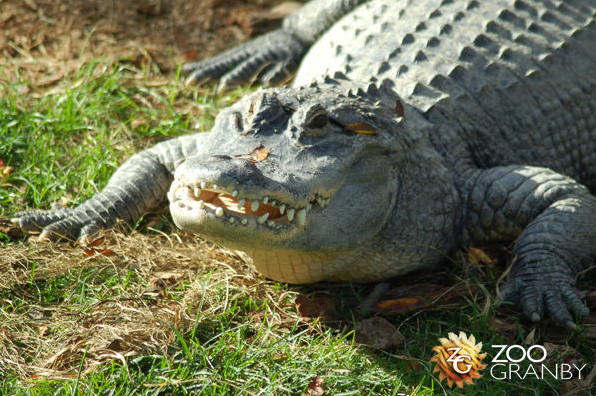 American Alligator
American Alligator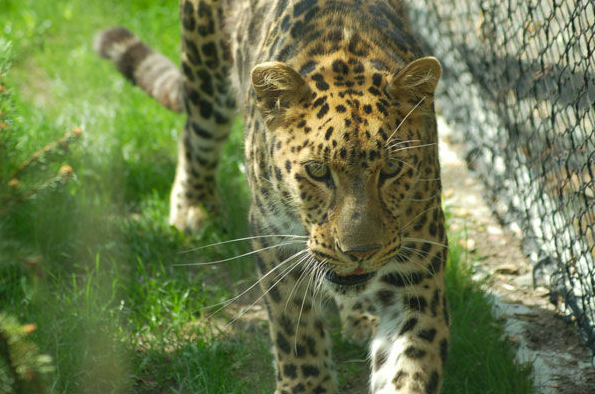 Amur Leopard
Amur Leopard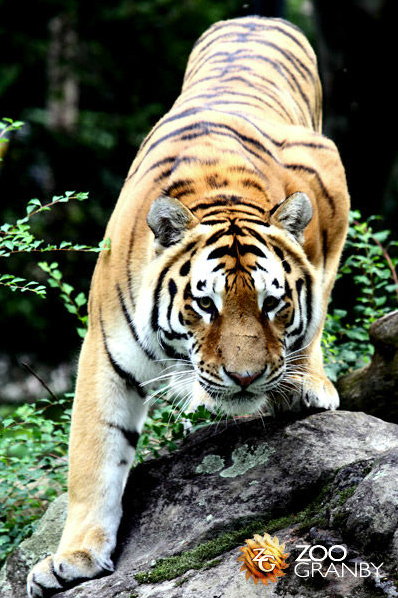 Amur Tiger
Amur Tiger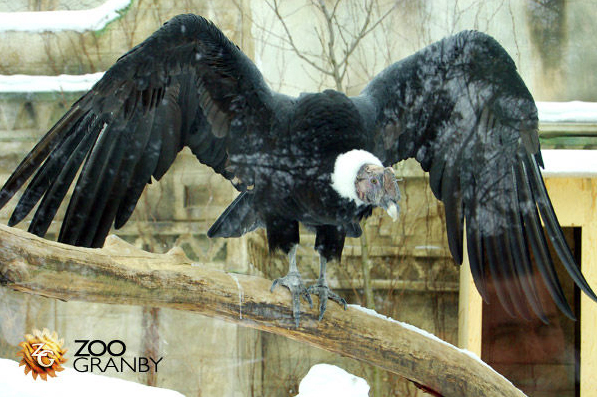 Andean Condor
Andean Condor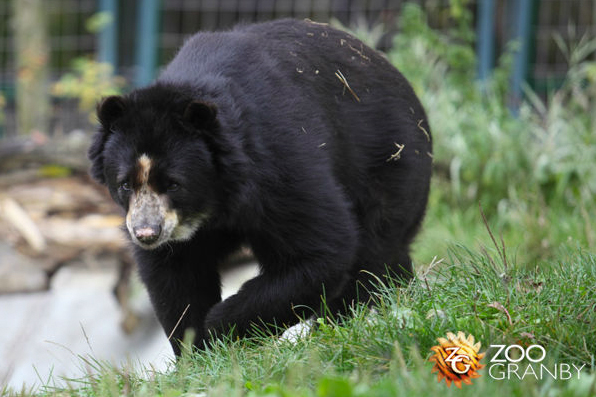 Asiatic Black Bear
Asiatic Black Bear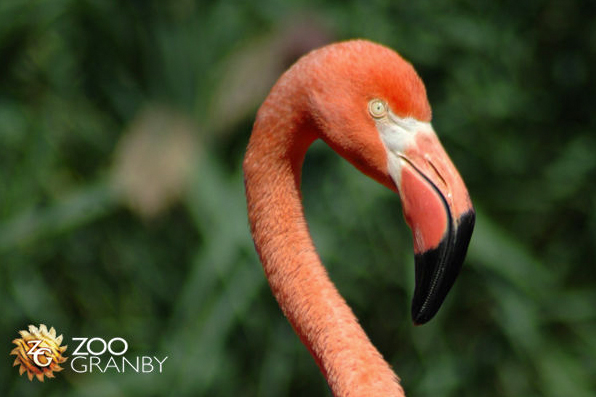 Greater Flamingo
Greater Flamingo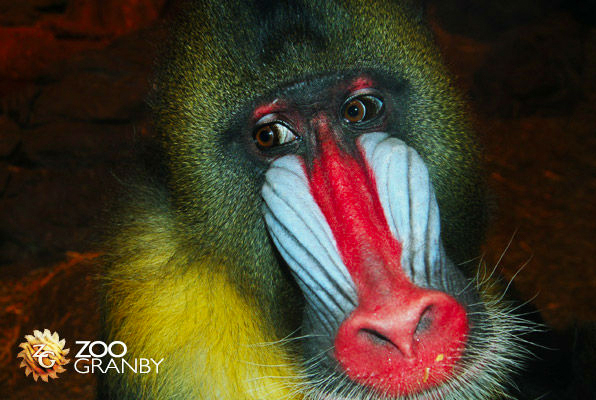 Mandrill
Mandrill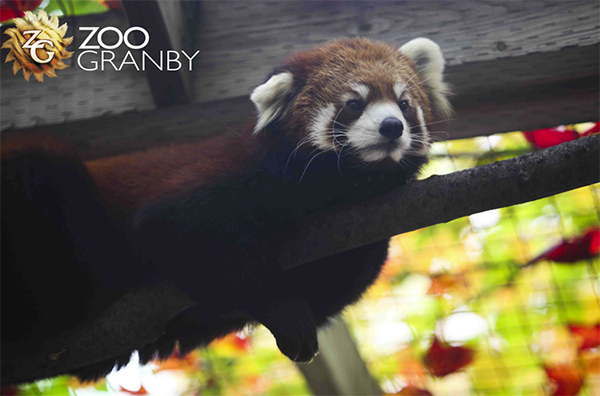 Red panda
Red panda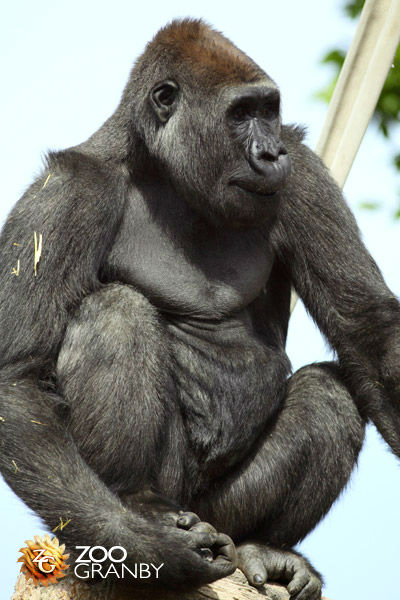 Western Lowland Gorilla
Western Lowland GorillaAucun point d'intérêt trouvé!
Catégories
Porte d'Afrique
Porte d'Asie
Porte Amérique du sud
Liste des points d'intérêts
>
American AlligatorZoo Area: African Savanna
Family: Alligatoridae
Class: Reptiles
Region: North America
Status: Least concern
An alligator has about 60 teeth, but it will have up to 3 000 teeth throughout its lifetime. The American alligator has a dark long greyish body covered with thick scales which gives it a prehistoric look. The scales are bony plates that insure protection against dehydration. This reptile is adapted to live in water and on land with its long tail that enables it to swim and its short legs enable it to crawl on land. Because the nostrils are located on top of the nose, the alligator can breath with its submerged body and will remain well camouflaged with just its nose sticking out of the water. It can measure between 1,5 to 5,9 meters (5 to 19 feet) and weigh between 200 and 230 kg (440 to 500 lbs). It can live up to 62 years. It prefers wetlands like swamps and rivers in south eastern United States. It is a carnivore which feeds on a variety of preys like fish, mammals and turtles. It can swim silently without a ripple on the water as it closes in on a prey to surprise and leap on it in order to catch it. The American alligator is a gregarious species that does not migrate. A group has a hierarchy, the dominant male will defend a group of females and protect a territory which comprises the nesting sites and food access against other males. Females will fight for the better nesting sites. Unlike other reptiles, the female has a well developed maternal instinct and will take care of the young. A female can lay from 25 to 60 eggs in a nest made of vegetation and soil. The young and eggs are the prey of many predators like the raccoon and snake. However, an individual of a meter long does not have any natural predator. It is hunted for its skin of which people make belts and purses. The American alligator is not considered as an endangered species anymore, but hunting is illegal since this reptile could be mistaken for the American crocodile which is an endangered species.
Amur LeopardZoo Area: Asia
Family: Felidae
Class: Mammals
Region: Asia
Status: Critically endangered
This wild cat is almost extinct in the wild. The Amur Leopard has a golden fur with black rosettes and a whitish belly. Males are usually 50% larger than females. A male can weigh from 32 to 91 kilos (70 to 220 lbs) and a female can weigh between 25 and 59 kilos (55 to 130 lbs). An adult can measure between 210 and 255 cm (84 and 120 in) from the head to the tip of the tail. The thick winter fur can be 7 cm (2.8 in) long. It has a slender shape with a round head with long legs and a long bushy tail. There are nine leopard subspecies according to IUCN (International Union for the Conservation of Nature) and all are threatened to a certain degree. Leopards have keen senses for finding preys, except for smelling which is weaker than that of other animals. This is an opportunistic hunter which feeds on Sika deers and other deers, wild boars, badgers as well as small rodents. It is the leopard with the most Nordic distribution which runs along the Amur River in Russia and China, thus it has been named after this river. It is found in forests close to rocky cliffs of south-eastern Russia, close to the city of Vladivostok and in a few areas of China. This species is in appendix I of CITES which protects against the international illegal fur & body parts trade. The main threats are poaching and loss of habitat from deforestation and frequent forest fires, as well as habitat fragmentation because of human populations’ expansion. The Amur Leopard is considered a critically endangered species; it is estimated that there are only 20 to 26 individuals left in the wild.
Amur TigerZoo Area: Research Center
Family: Felidae
Class: Mammals
Region: Asia
Status: Endangered
The Siberian Tiger becomes the Amur Tiger! The Amur tiger is the largest of all cats. It is easily recognized with the tawny coloured fur covered with vertical black stripes on its back and flanks. It is the only wild cat with a striped fur instead of a spotted one. The stripes will fragment the tiger’s silhouette, which makes it very difficult to spot in the long grassy environment of its habitat. The Amur tiger, known as the Siberian Tiger, does not have Siberian roots but only the name since it has rarely been living in Siberia; the boarder of its habitat is the long Amur river in the Russian Federation. This large cat is particularly well adapted to catch and kill large preys. Tigers are fast and can jump high and in long strides. They can reach a speed of up to 50 km/h. The senses are well developed along with the powerful front legs and strong jaws which do not leave much chance to wild boars, deers and other large mammals which it feeds on. Its night vision is excellent. A male can weigh from 180 to 360 kg (396 to 792 lbs) and a female from 100 to 167 kg (220 to 367 lbs). The body length can measure up to 1,4 to 1,8 meter long (4.5 to 5.9 feet), without the tail. The distribution includes northern China, northern Korea and the extreme south western part of Russia. The Amur tiger is found in the tropical and temperate forests, on mountain slopes or in riverside valleys. This big cat is nocturnal and usually solitary. A female gives birth to two to five young at a time after a gestation period of about 3 ½ months. An adult has no natural predators. The young can be the prey to brown bears and male Amur tigers. An individual can live about 15 years in nature. The main threats for the survival of the species are the massive habitat destruction as well as poaching. The Amur tiger is an endangered species in appendix I of CITES, there are about 400 individuals in nature (1998).
Andean CondorZoo Area: South America
Family: Cathartidae
Class: Birds
Region: South America
Status: Near threatened
The Andean Condor is one of the best long-flight birds of the world. The Andean Condor has the third place with regards to the wingspan of 3,2 m (10,5 pi) of all the birds which are able to fly. The male can weigh between 11 and 15 kg (24 and 33 lb) and can be 1,3 m (51 in) tall. The plumage is black with some white, the neck and head are bare (without feathers) and there is collar of white feathers around its neck. The male is larger than the female and can be differentiated with the crest up on its head. It can soar for hours with its large wings. It can also be seen perched in groups grooming each other or simply with the wings opened for hours. Eyesight is keen, Condors can see Turkey Vultures which will fly down below and then can spot their findings and chase them away. An individual bird will fly over one part of the area and will be joined by other condors when there will be a find. The Andean Condor can be found in the high range mountains, the Andes Cordillera, of the continent of South America, from Venezuela to Argentina. It will feed on carrion of wild and domestic carcasses, which it can eat about two kilos (4,4 lb) of meat per day. This bird can lay only one egg, every other year, on a rocky ledge of a cliff where they nest. Both parents will incubate the egg and it will hatch after about two months (54 to 59 days). An adult does not seem to have any natural predators and an individual can live up to 60 years in captivity. Even if today it still remains a symbol of power for the South Americans, this majestic bird is still being shot and it is also a victim of pollution and deforestation. Programs towards the reintroduction of this bird in the Andean Cordillera contribute to increase the numbers of individuals of this endangered species.
Asiatic Black BearZoo Area: Asia
Family: Ursidae
Class: Mammals
Region: Asia
Status: Vulnerable
This bear looks like our North American Black Bear! The Asiatic Black Bear is built with a powerful body and is very similar to the American Black Bear with regards to the size, black colour and dense fur. What is different from its American cousin is the cream coloured crescent shape marking on its neck along with the thick mane of long black hair around its head. It can climb, swim, and dig. It is capable of lightning accelerations approaching 50 km/h (30 mi/h). A male weighs from 100 to 200 kg (220 to 440 lbs), whereas a female weighs 50 to 125 kg (110 to 275 lbs). The body length can reach 140 to 200 cm (56 to 80 in). Bears have an excellent sense of smell and fine hearing. This bear species is found all over southern Asia, in forests in mountains up to an altitude of 2730 m (9000 ft) up in the Himalaya. This nocturnal animal spends most of its day up in trees not only to feed but also to sleep. This omnivorous animal can be active during the day. It feeds mostly on insects, a variety of fruit, seeds and nuts, and sometimes even meat. It is mostly solitary but will interact regularly with other individuals from the same species. It is during hibernation that a female will usually give birth to two or three cubs. The total gestation period can last for up to 150 days (5 months) where the embryos will only begin developing during the last 42 to 56 days. An individual can live about 25 years in nature. An adult has very few predators, mainly the Amur Tiger, but the Brown Bear can attack cubs. Although the Asiatic Black Bear is protected, it is still being illegally hunted today. The illegal but lucrative market for its gall bladder, make it very difficult to protect this animal that is being killed by poachers. The Asiatic Black Bear is an endangered species and is in appendix I of CITES (Convention of International Trade of Endangered Species).
Greater FlamingoZoo Area: Africa
Family: Phoenicopteridae
Class: Birds
Region: Africa and Asia
Status: Least concern
Pigments contained in the food give the flamingo its pink coloration. Flamingos are unique birds, not only because of their pink plumage and their curved beak but also because of the way they feed, their distinctive habitat and their capacity to resist extreme living conditions like very high temperatures. The Great Flamingo can weigh from 2.1 to 4.1 kg (4.5 to 9 lbs) and can be 120 to 145 cm (48 to 58 in.) tall. The wingspan varies between 140 and 165 cm (56 to 66 in.). The long legs with webbed feet are particularly well adapted to enable the bird to easily move about in muddy substrate without sinking in, while feeding. It can also swim if it has to go to deeper waters in order to feed. We usually find it in shallow lagoons and deltas as well as lakes. Since preys are of tiny proportion (algae, diatoms and invertebrates), the bird must filter the water with the ridges of its beak in order to extract the food from the water. The sense of smell is not well developed but the eyesight is good. They have a wide distribution ranging from Caribbean, Galapagos Islands, South Africa, Mediterranean Sea, Red Sea, western coast of Africa, India and Sri Lanka. This is a gregarious bird: one colony can gather up to one million individuals. These very vocal birds use a series of ritualized postures to communicate amongst each other. Each pair will raise only one young which will be fed a nutritive substance produced by an oesophagus gland. Adults have no natural predators; young ones can be the prey of birds of preys, gulls and foxes. Flamingos can live about 50 years old in nature. This fascinating bird was rarely been hunted by humans. The Great Flamingo is not considered as an endangered species.
MandrillZoo Area: African Pavillion
Family: Cercopithecidae
Class: Mammals
Region: Africa
Status: Vulnerable
This African monkey is known as the most colourful mammal. The mandrill is one of the most colourful mammals in the world. The fur is a dark olive brown colour with a yellow mane like beard. The typical coloration is more apparent in the male which has a red nose with blue crests on each side, reddish blue buttocks and genital organs with a touch of purple. These colours become vivid when the animal is excited or annoyed. This fact, along with different facial expressions and the demonstration of its long dreaded canines is the way that a mandrill uses to communicate with other individuals of its species. Even if it is mainly terrestrial, this primate can rapidly climb up trees and jump from branch to branch at a height of two to five meters above the ground. The male can weigh up to 30 kilos (66 lbs) and is twice as heavy as a female; a male is about one meter (3 feet) tall. Like the majority of monkeys, it can see colours and has an excellent vision. The mandrill is found in Africa, in the tropical forests of Cameroon, Congo, Gabon and equatorial Guinea. It feeds mainly on fruits, nuts and small vertebrates. The mandrill lives mainly on the ground, in groups of about 15 individuals, made up of one dominant male and a few females with their young. In the dry season, they can regroup in large herds including up to 250 individuals. A female will give birth to only one young after a gestation period of about six months. Predators that can attack an adult include the leopard, the eagle and the snake. The mandrill can live from 30 to 40 years in nature. This is an endangered species because of hunting for the meat and the loss of habitat due to deforestation for agriculture.
Red pandaZoo Area: Asia
Family: Procyonidae
Class: Mammals
Region: Asia
Status: Vulnerable
This small mammal has a very slow metabolism much like that of a sloth! With its red and black coat, the red panda has a long bushy stripped tail, a facial mask and a raccoon like physical shape. Its length ranges between 50 and 60 cm (20 and 24 in) with a tail that can reach 50 cm (20 in) long and the weight varies between 3,0 and 6,2 kg (6,5 and 13,6 lbs). Its thick fur, as well as its metabolism and behaviour make it a well adapted animal to very cold winters. Its senses aren’t particularly remarkable, but smell plays a very important role in social interactions during reproduction and when marking territory. The red panda lives in altitude where the mountain forests of the Himalayan range are located. The countries where it can be found are Nepal, India, Bhutan, Myanmar and China. The bamboo in these countries counts for a large part of its diet, despite its carnivorous dentition. It possesses a false thumb or sixth finger that helps in seizing bamboo sticks. Omnivorous, it eats a variety of food ranging from bamboo sticks to small animals. An excellent climber, it is considered a solitary animal and is mainly active from dusk to dawn. After mating, embryo implantation is delayed so that births occur in the summer and the total gestation period varies between 114 and 150 days, the phase in which the embryo develops lasts only 90 days (three months). The mother takes good care of her young, ranging between one and four, until they reach one year old. It can live between eight and ten years in the wild. The snow leopard is the main natural predator. The red panda populations suffer greatly from human activities such as hunting and habitat destruction. It is considered a vulnerable species according to the IUCN and is classified in appendix I of the CITES. Conservation measures are being taken in order to preserve the populations, both in the wild and in captivity.
Western Lowland GorillaZoo Area: African Pavillion
Family: Hominidae
Class: Mammals
Region: Africa
Status: Critically endangered
The largest ape on earth does not eat any meat. Gorillas are the largest apes on earth. Their black skin is covered with a rough black or brown fur. Gorillas are probably one of the animals that touch human’s heart and imagination the most. The strong and massive body shape and human like face is a fascinating mix. Gorillas can climb trees despite their large size, but their enormous muscular figure limits their moves in trees. The size varies between 1.4 and 1.8 metre (4.5 to 6 feet) in an upright position. The male’s weight can vary between 140 and 275 kg (300 to 600 lbs) and that of a female can vary between 60 and 140 kg (130 to 300 lbs). On the ground, gorillas walk on all four, leaning on their knuckles and standing on the ball of their feet. Their senses are similar to those of humans; they have an excellent eyesight and colour vision. The Western Lowland Gorilla is diurnal and is found in the tropical forests of Western Africa as well as Central and Eastern Africa. Gorillas are strict herbivores feeding mostly on fruit and leaves. They live in small groups lead by a dominant adult male called “silverback”. One of the male’s roles is to protect its group from predators. A female will give birth to only one young at a time every four years. This mammal can live up to 35 years in nature. An adult has no predators, only a leopard could attempt to attack this animal. The most important threat comes from human creating a loss of habitat and who also hunts entire populations for the meat. The Western Lowland Gorilla is an endangered species.
Aucun point d'intérêt trouvé!
 American Alligator
American Alligator Amur Leopard
Amur Leopard Amur Tiger
Amur Tiger Andean Condor
Andean Condor Asiatic Black Bear
Asiatic Black Bear Greater Flamingo
Greater Flamingo Mandrill
Mandrill Red panda
Red panda Western Lowland Gorilla
Western Lowland GorillaAucun point d'intérêt trouvé!



